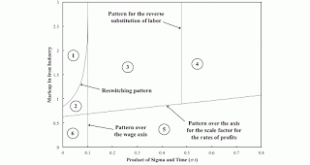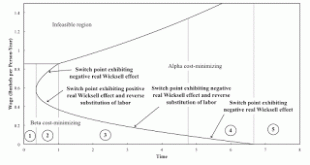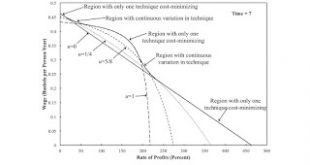Figure 1: A Two-Dimensional Pattern Diagram The example in this working paper is of an economy in which two commodities are produced. Technical progress is modeled as decreasing the coefficients of production in one of the processes for producing corn. They decrease at a rate of σ of ten percent. Figure 2 shows how the pattern of switch points vary with technical progress. Initially, the Beta technique is cost-minimizing. Then it becomes a reswitching example. Around the switch point at...
Read More »Structural Economic Dynamics, Real Wicksell Effects, and the Reverse Substitution of Labor
I have uploaded another working paper: This article presents an example in which technical progress results in variations in the labor market. Around a switch point with a positive real Wicksell effect, a higher wage is associated with firms wanting to employer more labor per unit output of net product. Around a switch point with a reverse substitution of labor, firms in a particular industry want to hire more labor per unit output of gross product. Technical progress can bring about...
Read More »A Visualization of the Choice of Technique
Figure 1: Regions for Basis Variables 1.0 Introduction I introduced a new way of visualizing the choice of technique for two-commodity models back in 2005. As far as I know, nobody has taken up this idea. I modify my method slightly by having labor advanced; wages are paid out of the surplus at the end of the year. I cite John Roemer in my paper linked previously. 2.0 Technology Table 1 specifies the technology I use for illustration. Each row lists the inputs needed to produce one...
Read More »Normal Forms For Switch Point Patterns: A Research Agenda
I have been looking at the effects of perturbing parameters in models of the choice of technique. Now that I have one paper out of this research published, I thought I would recap where I am. I think I should be able to get at least another paper out of this. A challenge for me is to draw interesting economics out of these findings. In a sense, what I am doing is applied mathematics, albeit with more an emphasis on numerical exploration than proof of theorems. I claim that the development...
Read More »Cambridge Capital Controversy Applied At The Level Of The Firm
For a number of decades, Arrigo Opocher and Ian Steedman have been developing arguments that apply the CCC to industries and even individual firms. They also draw on mainstream literature in microeconomics, from the 1960s and 1970s. Their 2015 book is a major statement of their position. Since their book's publication, they have continued research in this vein. The CCC applies whenever you see a production function with capital measured in numeraire-units. This can be an aggregate...
Read More »An Opportunity For The Working Class With Increased Markups
A Switch-Point Perturbation Diagram I have a new working paper at SSRN. Abstract: This article presents an analysis based on a comparison of stationary states. With technology and relative markups among industries taken as exogenous, the long-period trade-off between wages and rates of profits is determined. A long-period change in relative markups among industries can create a switch point exhibiting capital-reversing. Around such a switch point, a higher wage is associated with firms...
Read More »On the Gain and Loss from Trade
I have written up my recent explorations in the theory of international trade. Abstract: This article considers a model of international trade in which the number of produced commodities does not exceed the number of countries engaged in trade. Technology is modeled such that each commodity can be produced in each country from a finite series of dated labor inputs. The existence of a positive rate of profits may lead a country to specialize differently than how it would with a zero rate...
Read More »Class Struggle And Specialization In International Trade
This post continues a previous numeric example. The firms in each of three countries are assumed to know a technology for producing corn, wine, and linen. The technology is such that each commodity can be produced in each country. The technology varies among countries. Each of these small open economies can specialize and obtain non-produced commodities through foreign trade. I confine myself to patterns of specialization in which: Each country produces exactly one commodity...
Read More »Structural Economic Dynamics with a Choice of Technique in General
Many - not all - of my recent numerical examples have a certain abstract pattern: At the start of the time under consideration, one technique is uniquely cost minimizing, for all feasible rates of profits. Coefficients of production decline or some markups over the normal rate of profits vary. A fluke switch point appears. Switch points move along the wage frontier, and interesting phenomena occur. These can be other fluke switch points. Reswitching, the recurrence of techniques,...
Read More »A Reswitching Pattern With A Continuum Of Techniques
Recurrence Of Techniques Without Switch Points I have built on my previous post in a writeup: Abstract: In certain models of commodities produced by means of commodities, the choice of technique is analyzed by the construction of the wage frontier. This article presents a numeric example of a continuum of wage curves tangent at a switch point. Technological progress leads to the recurrence of techniques. No switch points then exist, but the cost-minimizing technique varies continuously...
Read More » Heterodox
Heterodox





